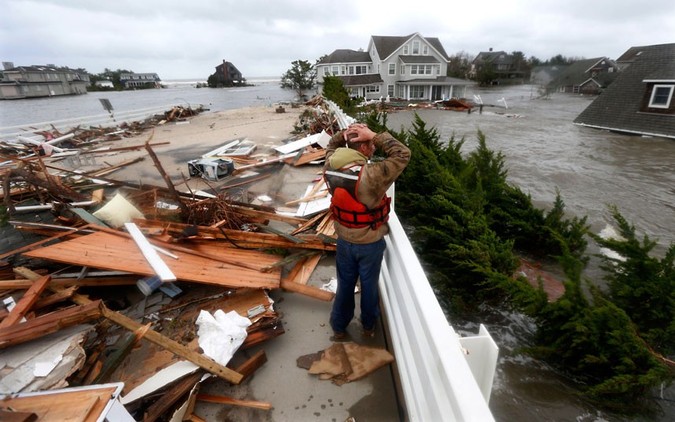The Wrack
The Wrack is the Wells Reserve blog, our collective logbook on the web.
The Wrack is the Wells Reserve blog, our collective logbook on the web.
 Mantoloking, New Jersey, October 30, 2012.
Mantoloking, New Jersey, October 30, 2012.The following was published in the Biddeford-Saco Journal Tribune Sunday edition, 8/30/2015. (Continued from Remembering Katrina, Part I.)
Ten years ago this week, Category 3 Hurricane Katrina left nearly 2,000 people dead, hundreds of communities uprooted, and more than $100 billion in damage along the Gulf Coast. Adding in Superstorm Sandy’s devastation in October 2012, just two events swallowed the equivalent of: five months of Medicare spending, or two years of the federal education budget, or four years’ worth of the Federal Highway Trust Fund, our national gasoline tax-funded infrastructure bank that is now running on empty. So much money, washed out to sea.
Natural disasters are unbelievably costly, and their effects can linger for decades. What do we have to lose here in Southern Maine? A lot. As just one example: according to Jon Carter, Town Manager of Wells, two-thirds (~$2 billion) of the town’s property valuation lies between the ocean and Route 1. That’s real money, plus tourism assets that include 5% of the state’s annual lodging tax revenues, in the coastal storm danger zone.
We know we have a lot to lose. And we know hurricanes happen. They always have. There’s no stopping them; they’re too large, too powerful, and they may even serve as a necessary “release valve” for tropical heat. All we can do is prepare, hunker down (or, better yet, evacuate), and rebuild after they pass.
The will to prepare, however, is crucial, and it is continually sapped the longer we go since “a big one.” So it was in New Orleans before Katrina, so it was in New Jersey before Sandy. For us up here in Maine, it’s been a while.
Category 2 Hurricane Bob was the last major hurricane to hit the Northeast. Bob came ashore in Rhode Island in August 1991 and then moved over the Cape and into the Gulf of Maine, where it clipped our state with 90 mile-per-hour winds in Wiscasset. In Connecticut, where I lived, the storm surge from Bob came 20 miles up the Connecticut River and swamped our local riverside airport. I’d never seen anything like it, and I haven’t since.
But that was 24 years ago and still a relatively small storm. We can all be forgiven for thinking “those kinds of really big storms don’t happen in Maine.”
Except that they do. More than thirty Category 3 and even Category 4 storms have hit Maine and Cape Cod. We just weren’t here when they did. Clues recently unearthed in Scarborough Marsh and from salt marshes near Falmouth, Mass., reveal that powerful coastal storms ravaged our region on average every 40 years from AD 150 to AD 1150, and then again in early colonial times between 1400 to 1675.
Tellingly, the field of paleotempestology – the study of prehistoric storms – says that those storms were formed over waters that were historically warmer than the average of the past hundred years. Our warming East Coast waters are now getting back to those levels. We’ve been in a quiet period up here for a couple hundred years, but that doesn’t necessarily mean we live in a quiet place.
That’s the real challenge of climate change. No one disputes that the climate hasn’t always changed. It’s definitely been warmer and stormier in the past. What’s different and concerning now is that all our human stuff – houses, economies, ways of life – is standing in harm’s way. The hurricane trains have always run up the East Coast, but in the past hundred years, we started parking our cars on the tracks. We have to accept that inconvenient truth, don’t we?
It’s forehead-slapping obvious, but it always bears repeating: by adding a few more ounces of prevention, we can save tons of cure. As “Federal Response to Hurricane Katrina: Lessons Learned,” the definitive federal report on what went wrong in that disaster’s response, states, “Hurricane Katrina necessitated a national response that Federal, State, and local officials were unprepared to provide.” Help does eventually arrive, but if you want to truly weather the storm well, it’s up to you to plan ahead.
Through “The Sandy Dialogues,” a storytelling project the Wells Reserve at Laudholm ran this past year with our sister estuarine research reserve in New Jersey, we learned a number of lessons about preparedness. Over and over we heard “if only we had done this, or if we had not done that, we would have saved millions of dollars or months of time.” Planning resources and tools abound; here are a few questions they, and the Wells Reserve, offer for consideration.
Some preparations are obvious, some are subtle. (My personal favorite: sure, those old paint cans and cleaning supplies look safe on the shelves in my basement, but when floodwaters wash them into my yard, I’ll have my own personal Superfund site. Hmmm. September is National Preparedness Month, so after Labor Day, I’m taking them to the transfer facility.) Decades of community, nonprofit, and governmental disaster responses have taught the world more than enough to learn about preparedness and recovery. We have to bravely face the inevitability of disruption.
A waitress in New Jersey, tearfully recounting her harrowing tale a year later to our “Sandy Dialogues” project team, said: “at least we’ll never have to go through that again.” I hope, for her sake, that she meant that, when the next storm inevitably arrives, she’ll be better prepared. You can be too.
Nik Charov is president of Laudholm Trust, the nonprofit partner of the Wells National Estuarine Research Reserve in Wells, Maine. His Sunday column, “Between Two Worlds,” ventures forth from the intersection of art and science, past and future, hurricanes and extratropical storms. More at wellsreserve.org/twoworlds.